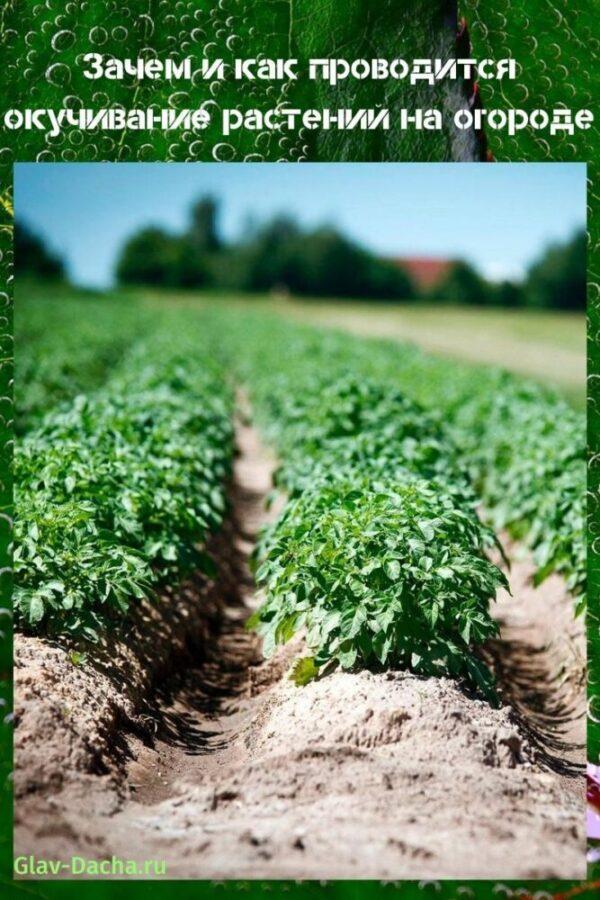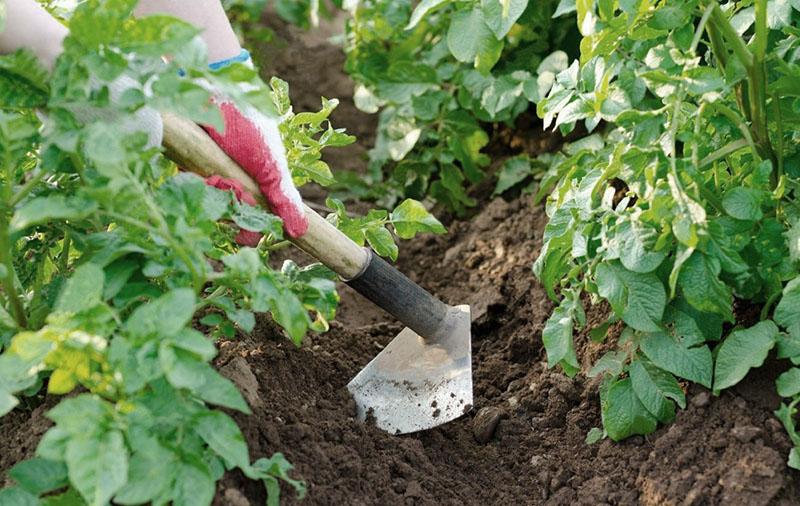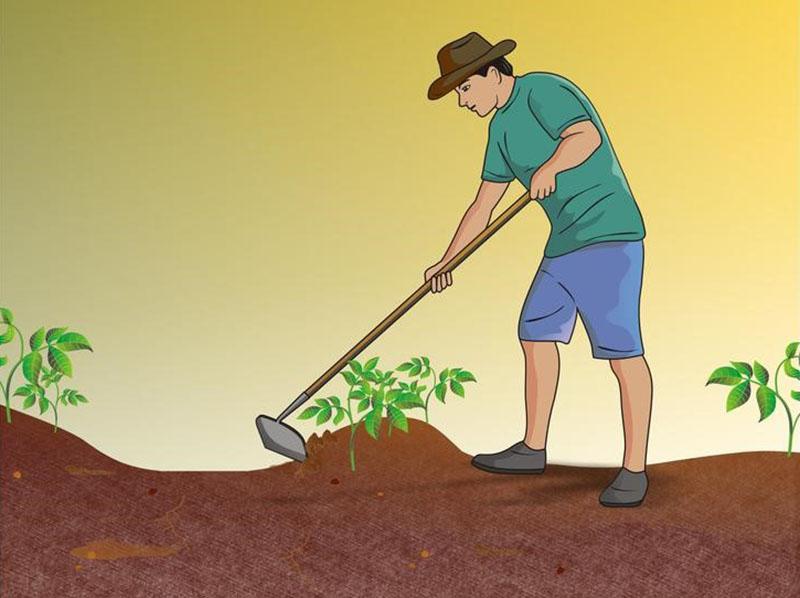Why and how the hilling of plants in the garden is carried out
 There is nothing better for a person than to enjoy the fruits of his labor. To achieve the cherished goal, gardeners carry out hilling plants one or more times per season. The agrotechnical procedure provides vegetable crops with comfortable conditions for successful development.
There is nothing better for a person than to enjoy the fruits of his labor. To achieve the cherished goal, gardeners carry out hilling plants one or more times per season. The agrotechnical procedure provides vegetable crops with comfortable conditions for successful development.
Many farmers use hilling only for potatoes. However, other vegetables also need additional cultivation. Let's figure out the importance of hilling plants for their development and increasing yields. What vegetable crops need the procedure? How to do it correctly? The answers to the questions will help you understand the essence of dacha farming. And put into practice, improve craftsmanship and get bountiful harvests.
Simple hilling of plants is a reliable investment of time and energy

 The procedure for hilling plants consists in increasing the earthen mound around the root system of the crop. The soil should be loose and without weeds... It is carried out manually or mechanically on loamy and clayey soil.
The procedure for hilling plants consists in increasing the earthen mound around the root system of the crop. The soil should be loose and without weeds... It is carried out manually or mechanically on loamy and clayey soil.
On sandy soil, the event is not carried out, since the water quickly rolls down and practically does not get into the near-trunk area.
Thanks to hilling, the plant sprouts new roots, which contribute to:
- assimilation of more nutrients;
- anchoring the culture in the ground so that it can withstand gusts of wind and heavy rainfall;
- uninterrupted oxygen supply;
- growth stimulation.
 In addition, vegetable crops become more resistant to disease. Resist pests, bear fruit better. An earthen mound regulates the flow of moisture and temperature. Protects against leaching of minerals from the soil. Prevents crops planted for the winter from freezing. Serves as a bleaching agent for asparagus and leeks.
In addition, vegetable crops become more resistant to disease. Resist pests, bear fruit better. An earthen mound regulates the flow of moisture and temperature. Protects against leaching of minerals from the soil. Prevents crops planted for the winter from freezing. Serves as a bleaching agent for asparagus and leeks.
The procedure for hilling plants is best done after heavy rain in the morning or evening. Moisture-saturated soil takes on a crumbly character and is easy to form a hill.
However, one should not get too carried away with loosening the soil. For example, potato roots practically do not recover after damage. And during dry periods, hot ground does not stimulate the growth of additional branches of the root system.
Agrotechnical technique is performed at an early stage of development of vegetable crops, so as not to damage young shoots.
What vegetables need hilling
 Agronomists advise using the procedure for plants that sprout additional growth underground. Thanks to this, they get the maximum of nutrients from the soil. Some root vegetables lose their flavor and color due to direct sunlight. Therefore, a small hill made of soil is a "lifeline" for them. First, consider the practical implications of hilling for corn, potatoes and tomatoes. And then, we will find out the benefits of the agrotechnical technique for peppers, cucumbers and winter garlic.
Agronomists advise using the procedure for plants that sprout additional growth underground. Thanks to this, they get the maximum of nutrients from the soil. Some root vegetables lose their flavor and color due to direct sunlight. Therefore, a small hill made of soil is a "lifeline" for them. First, consider the practical implications of hilling for corn, potatoes and tomatoes. And then, we will find out the benefits of the agrotechnical technique for peppers, cucumbers and winter garlic.
Corn
 The plant is one of the most cultivated crops in the world. Gardeners grow it for animal feed. Sugar varieties are used to obtain ears.When the threat of frost fades into oblivion, corn is sown in open ground. The emerging seedlings are carefully weeded, removing the weeds. After 2-3 weeks, the hardened plants are covered with loose moist soil. The embankments are made about 20 cm in height and 15 in width. As a result, the plant sprouts additional roots, which will become a reliable "support" for it.
The plant is one of the most cultivated crops in the world. Gardeners grow it for animal feed. Sugar varieties are used to obtain ears.When the threat of frost fades into oblivion, corn is sown in open ground. The emerging seedlings are carefully weeded, removing the weeds. After 2-3 weeks, the hardened plants are covered with loose moist soil. The embankments are made about 20 cm in height and 15 in width. As a result, the plant sprouts additional roots, which will become a reliable "support" for it.
Dense corn crops that are grown for green forage are simply weeded out thoroughly.
Potatoes
This technique has long been used for potatoes in order to obtain bountiful harvests. Depending on the size of the garden, it is performed in different ways. Large areas are cultivated with a tractor or walk-behind tractor... Gardeners huddle the plant by hand.  The first time the procedure is done when the first 3-4 leaves appear. The plant is completely covered with earth, forming small mounds.
The first time the procedure is done when the first 3-4 leaves appear. The plant is completely covered with earth, forming small mounds.
Greens covered with soil are reliably protected from frosts, which often return in late spring.
 The second time hilling is carried out when the tops of the potatoes rise by about 15-20 cm. The earth is shoveled onto the root area, holding the juicy greens with your hands. If desired, the procedure is repeated after a week.
The second time hilling is carried out when the tops of the potatoes rise by about 15-20 cm. The earth is shoveled onto the root area, holding the juicy greens with your hands. If desired, the procedure is repeated after a week.  When the potatoes throw out the buds, it is better to leave the garden alone. For the plant, any invasion will be stressful, which affects the yield.
When the potatoes throw out the buds, it is better to leave the garden alone. For the plant, any invasion will be stressful, which affects the yield.
Tomatoes
 Novice gardeners often wonder whether it is necessary to huddle tomatoes in order to promote the fruiting of the crop. In fact, there are two opinions. Some believe that the plant does not need a procedure. Others argue that without hilling, it will hurt and bear less fruit. Therefore, each gardener makes a personal decision, taking into account a number of factors.
Novice gardeners often wonder whether it is necessary to huddle tomatoes in order to promote the fruiting of the crop. In fact, there are two opinions. Some believe that the plant does not need a procedure. Others argue that without hilling, it will hurt and bear less fruit. Therefore, each gardener makes a personal decision, taking into account a number of factors.
The benefits of hilling tomato bushes are manifested in such relationships:
- promotes air exchange;
- prevents stagnation of water;
- improves soil warming;
- retains moisture during drought;
- destroys weeds.
 Low-growing early varieties slightly huddle when planting, so that they take root faster. Later tomatoes with high branches without an additional mound will not withstand gusty winds and heavy rainfall. The procedure is carried out when the plant begins to grow rapidly. Usually one time is enough.
Low-growing early varieties slightly huddle when planting, so that they take root faster. Later tomatoes with high branches without an additional mound will not withstand gusty winds and heavy rainfall. The procedure is carried out when the plant begins to grow rapidly. Usually one time is enough.
Tall varieties also need a reliable support, which is built next to an earthen hill.
Pumpkin crops
 Lovers of crispy fruits are wondering whether it is necessary to spud cucumbers, pumpkin and zucchini. After all, these plants have hollow shoots that curl along the ground. Despite their delicate structure, pumpkin crops wonderfully release additional roots. However, the hilling procedure is performed very carefully so as not to damage the main root of the plant. Even the slightest "injury" to the system can lead to the death of a vegetable crop. Hilling is carried out in an unusual way.
Lovers of crispy fruits are wondering whether it is necessary to spud cucumbers, pumpkin and zucchini. After all, these plants have hollow shoots that curl along the ground. Despite their delicate structure, pumpkin crops wonderfully release additional roots. However, the hilling procedure is performed very carefully so as not to damage the main root of the plant. Even the slightest "injury" to the system can lead to the death of a vegetable crop. Hilling is carried out in an unusual way.
First, prepare a loose substrate by mixing such components:
- soil from the garden;
- humus;
- wood ash.
Sprinkle the resulting earth on the base of tender stems of cucumbers, zucchini or pumpkin. The first time hilling is done after the formation of at least 4 leaf plates. The procedure is repeated after approximately 21 days. The height of the embankment is about 15 cm.
Bell pepper
 To get a bountiful harvest of a fragrant fruit, it must be properly cultivated. Bell peppers are often grown from seedlings that are transferred from the greenhouse to the garden. When the time comes for weeding, the question arises whether it is necessary to sprinkle the peppers with loose earth. Some gardeners believe that this cannot be done. The main reason is the root system, which is located close to the surface. Any damage can lead to the death of the culture.
To get a bountiful harvest of a fragrant fruit, it must be properly cultivated. Bell peppers are often grown from seedlings that are transferred from the greenhouse to the garden. When the time comes for weeding, the question arises whether it is necessary to sprinkle the peppers with loose earth. Some gardeners believe that this cannot be done. The main reason is the root system, which is located close to the surface. Any damage can lead to the death of the culture.
Others are of the opinion that hilling stimulates the growth of peppers and fruiting. The procedure is performed according to a simple scheme.:
- first, the site is weeded, removing weeds;
- after 2 weeks, soil is raked around the bushes;
- the procedure is repeated during the ejection period.
If necessary, pepper bushes are spud up during abundant fruiting. The loosening depth depends on the soil structure. Greenhouse seedlings do not need hilling, since they will be transferred to the garden bed.
Winter garlic
 As a rule, the culture is planted in the garden in late autumn. During the winter, it will form a powerful root system, which will provoke rapid growth in the spring.
As a rule, the culture is planted in the garden in late autumn. During the winter, it will form a powerful root system, which will provoke rapid growth in the spring.
Garlic care includes a number of activities:
- cleaning spruce branches or other shelter;
- after the appearance of greenery, the plant is fed with nitrogen fertilizers;
- regularly weed the aisles;
- depending on weather conditions, moisten the soil.
 Is it necessary to huddle winter garlic to improve its development? Most summer residents do without this procedure. Because after weeding, the beds are covered with straw or dry grass. Regular loosening of the soil provides winter garlic with the necessary dose of oxygen and nutrients.
Is it necessary to huddle winter garlic to improve its development? Most summer residents do without this procedure. Because after weeding, the beds are covered with straw or dry grass. Regular loosening of the soil provides winter garlic with the necessary dose of oxygen and nutrients.
In the summer, the plant throws out arrows. When they grow to 15 cm, they must be carefully removed.
Competent hilling of vegetable crops contributes to rapid growth and improves fruiting. Each plant has its own scheme for performing the procedure. Some vegetables don't need it. Following the generally accepted rules will help grow large vegetables in the garden.